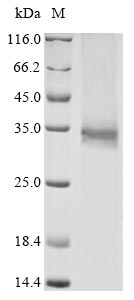Recombinant Bovine coronavirus Non-structural protein 2a (2a) is produced using a baculovirus expression system. The expressed protein covers the complete amino acid sequence from position 1 to 278. A C-terminal 6xHis-tag has been added to help with purification and detection processes. SDS-PAGE analysis confirms the protein achieves greater than 90% purity, which appears to make it suitable for research applications that demand high-quality protein preparations.
Non-structural protein 2a (2a) from Bovine coronavirus seems to play an important part in how the virus replicates and transcribes its genetic material. This protein is involved in processing the viral polyprotein and likely serves a critical function in the viral life cycle. Studying this protein may be key to understanding coronavirus biology better. Such research could potentially reveal new insights into viral replication processes, possibly opening doors to therapeutic approaches.
Potential Applications
Note: The applications listed below are based on what we know about this protein's biological functions, published research, and experience from experts in the field. However, we haven't fully tested all of these applications ourselves yet. We'd recommend running some preliminary tests first to make sure they work for your specific research goals.
The protein is expressed in a baculovirus system (eukaryotic insect cells), which supports more complex protein folding and some post-translational modifications compared to prokaryotic systems. Full-length expression (1-278 aa) preserves all functional domains, and the C-terminal 6xHis tag minimizes potential disruption to the protein's native structure. The high purity (>90%) reduces concerns about contaminant interference. However, no experimental validation of proper folding (e.g., by circular dichroism spectroscopy, thermal shift assays) or bioactivity (e.g., enzymatic activity, specific protein-protein interactions) is provided. While the baculovirus system is favorable for producing functional eukaryotic proteins, the correct folding and biological activity of this specific NSP2a preparation remain probable but unconfirmed.
1. Antibody Development and Validation Studies
This recombinant NSP2a is suitable as an immunogen for generating antibodies against BCoV NSP2a. However, antibodies produced should be validated for specificity using native NSP2a from infected cells, as even baculovirus-expressed protein may not perfectly replicate all post-translational modifications found in mammalian cells. The high purity and His-tag facilitate purification and assay development, but antibody functionality in detecting native viral protein should be confirmed.
2. Protein-Protein Interaction Studies
Pull-down assays using this His-tagged protein can identify potential interaction partners, but any interactions identified require validation through orthogonal methods (e.g., co-immunoprecipitation from infected cells). While the baculovirus system enhances the likelihood of proper folding, the physiological relevance of interactions discovered with recombinant NSP2a must be confirmed in the context of viral infection.
3. Biochemical Characterization and Structural Studies
This protein is appropriate for initial biochemical and biophysical characterization. Techniques such as circular dichroism spectroscopy and dynamic light scattering can provide valuable information about secondary structure and oligomerization state. However, conclusions about the native structure and stability should be tempered until comparative data with the native protein are available, as the recombinant protein may exhibit differences in folding or modification states.
4. In Vitro Assay Development
The recombinant NSP2a can serve as a standard or substrate for assay development, particularly for initial optimization and standardization. However, assays intended to measure authentic NSP2a function should be validated using native protein or cell-based systems, as the recombinant protein may lack full enzymatic activity or proper regulation present in the viral context.
Final Recommendation & Action Plan
This baculovirus-expressed BCoV NSP2a represents a valuable reagent for initial studies of this viral protein, with the eukaryotic expression system providing reasonable confidence in its structural integrity. The priority should be to validate the protein's folding state and biological activity through biophysical methods (circular dichroism, thermal shift assays) and functional assays relevant to NSP2a's proposed roles in the viral lifecycle. Once basic characterization is complete, the protein can be reliably used for antibody production, interaction studies, and assay development, with the understanding that key findings should be verified in more physiologically relevant systems when possible. For interaction studies specifically, results should be interpreted as preliminary until confirmed with native protein complexes from infected cells.






